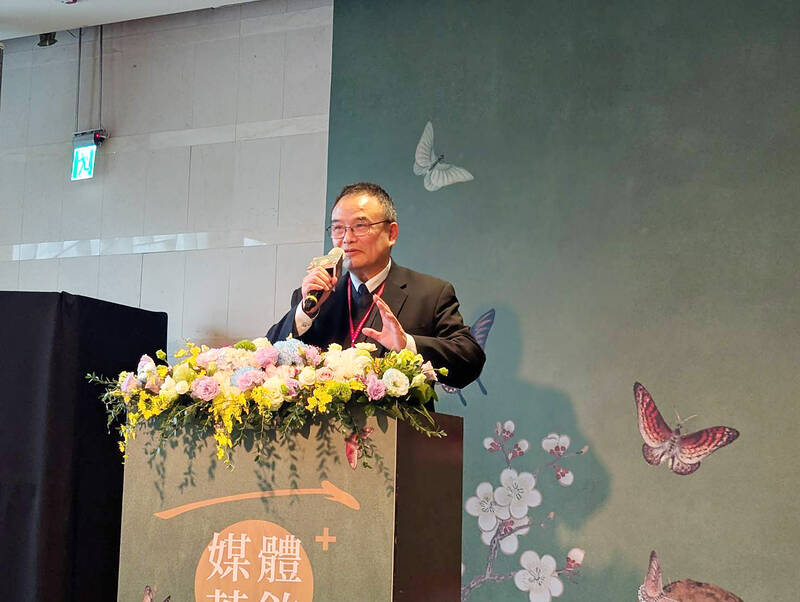The director of Taiwan’s National Palace Museum said he “hopes” the major tourist attraction can attract 3.5 million visitors next year, the 100-year anniversary of the museum’s founding in Beijing, despite current visitor numbers falling well short of the goal.
Speaking at a museum event on Tuesday, Director Hsiao Tsung-huang (蕭宗煌) said the museum has a goal of drawing 2.5 million visitors to its Northern Branch in Taipei and 1 million visitors to its Southern Branch in Chiayi County next year.
Official visitor numbers show that the Northern Branch only attracted 1.5 million museum-goers while the Southern Branch saw about 900,000 last year. The figures include domestic and foreign visitors.

Photo: CNA
From January to November this year, the Northern Branch welcomed nearly 1.7 million and the Southern Branch almost 900,000 visitors, official statistics show, reflecting a year-on-year rise, but still almost 1 million below the museum’s target for next year.
The ambitious 3.5 million visitor goal was set because of expectations that an improvement in cross-strait relations would lead to significantly greater numbers of Chinese visitors to the museum’s collections, Hsiao said.
The number of Chinese visitors to Taiwan plummeted from roughly 2.7 million per year in the late 2010s to a mere 329,000 in the first 11 months of this year due to the COVID-19 pandemic and Beijing’s ongoing ban of visits by Chinese tour groups to Taiwan.
Whether the ban would be fully or partially lifted next year remains unknown, but “regardless of whether the two sides of the Taiwan Strait open up next year, efforts will still be made to attract 3.5 million visitors,” Hsiao said.
Reflecting challenges facing Taiwan’s tourism industry more generally, the National Palace Museum — one of the country’s top attractions for overseas visitors — has struggled to return to pre-pandemic levels.
In 2019, before pandemic restrictions severely disrupted international travel, the National Palace Museum recorded 3.8 million visitors to its Northern Branch alone — more than twice as many as are expected to visit five years later.
Lagging visitor numbers are not the only challenge facing the museum which houses nearly 700,000 artifacts, including ancient bronzes, ceramics, jade items, paintings and carvings from China.
Also speaking at the event on Tuesday, the museum’s Administrative Affairs Deputy Director Huang Yung-tai (黃永泰) said the museum would report to the legislature “in the future” over the budget freeze imposed on the state-funded museum’s renovation.
Lawmakers this month froze the NT$350 million (US$10.7 million) budget for the New National Palace Museum Plan, casting doubt on whether the museum’s ongoing renovation project would be completed on time.
However, Huang said progress was being made on the renovation, with the Northern Branch’s library building expected to open as a second exhibition area in June.

TRAGEDY: An expert said that the incident was uncommon as the chance of a ground crew member being sucked into an IDF engine was ‘minuscule’ A master sergeant yesterday morning died after she was sucked into an engine during a routine inspection of a fighter jet at an air base in Taichung, the Air Force Command Headquarters said. The officer, surnamed Hu (胡), was conducting final landing checks at Ching Chuan Kang (清泉崗) Air Base when she was pulled into the jet’s engine for unknown reasons, the air force said in a news release. She was transported to a hospital for emergency treatment, but could not be revived, it said. The air force expressed its deepest sympathies over the incident, and vowed to work with authorities as they

A tourist who was struck and injured by a train in a scenic area of New Taipei City’s Pingsi District (平溪) on Monday might be fined for trespassing on the tracks, the Railway Police Bureau said yesterday. The New Taipei City Fire Department said it received a call at 4:37pm on Monday about an incident in Shifen (十分), a tourist destination on the Pingsi Railway Line. After arriving on the scene, paramedics treated a woman in her 30s for a 3cm to 5cm laceration on her head, the department said. She was taken to a hospital in Keelung, it said. Surveillance footage from a

Police have issued warnings against traveling to Cambodia or Thailand when others have paid for the travel fare in light of increasing cases of teenagers, middle-aged and elderly people being tricked into traveling to these countries and then being held for ransom. Recounting their ordeal, one victim on Monday said she was asked by a friend to visit Thailand and help set up a bank account there, for which they would be paid NT$70,000 to NT$100,000 (US$2,136 to US$3,051). The victim said she had not found it strange that her friend was not coming along on the trip, adding that when she

INFRASTRUCTURE: Work on the second segment, from Kaohsiung to Pingtung, is expected to begin in 2028 and be completed by 2039, the railway bureau said Planned high-speed rail (HSR) extensions would blanket Taiwan proper in four 90-minute commute blocs to facilitate regional economic and livelihood integration, Railway Bureau Deputy Director-General Yang Cheng-chun (楊正君) said in an interview published yesterday. A project to extend the high-speed rail from Zuoying Station in Kaohsiung to Pingtung County’s Lioukuaicuo Township (六塊厝) is the first part of the bureau’s greater plan to expand rail coverage, he told the Liberty Times (sister paper of the Taipei Times). The bureau’s long-term plan is to build a loop to circle Taiwan proper that would consist of four sections running from Taipei to Hualien, Hualien to